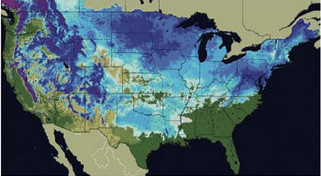 February 2011 in the Mile High City was a relatively uneventful one. Temperatures were below normal and we received less snow and precipitation than what is typical for the month.
February 2011 in the Mile High City was a relatively uneventful one. Temperatures were below normal and we received less snow and precipitation than what is typical for the month.
In terms of temperature, Denver officially recorded an average of 29.1 degrees during February as measured at Denver International Airport. While this is 4.1 degrees below normal, it was not cold enough to make ‘top 10’ status. Temperatures ranged from a high of 67 degrees on the 16th all the way down to a low of -17 on the 2nd. Neither of these was a record.
Here in Thornton we were slightly warmer with an average temperature of 29.6 degrees. We recorded a high of 69.3 degrees on the 16th and a low of -14.7 degrees on the 2nd.
One temperature record was set during the month and one tied. A new record low maximum was set on the 1st when the high temperature only climbed to -1 degrees. This broke the previous record of 2 degrees set in 1985. On the 8th the low maximum temperature of 8 degrees tied the mark last set in 1933.
In terms of snowfall, the month saw us record 5.3 inches – 1 inch below normal for February. This continued the trend for the snow season of below normal snowfalls and by the end of the month we were more than 20 inches below normal. Nearly half of that snow, 2.6 inches, fell during one storm on the 7th and 8th of the month. In all, only five days had snow and all of those were before the 9th of the month.
Precipitation was similarly below normal. A total of 0.42 inch was recorded which was 0.07 inch below the normal 0f 0.49 inch. Most of that was recorded during the same event that we received the biggest snow of the month mentioned above. Precipitation was recorded on five days with two of those recording 0.10 inch or more.
Thornton matched the Denver snowfall total of 5.3 inches. However we received much less precipitation from those snows and recorded only 0.29 inch of liquid moisture.
Below is the official Denver climate summary for February 2011. Click here to view Thornton’s February climate report.
CLIMATE REPORT
NATIONAL WEATHER SERVICE BOULDER, CO
830 PM MST TUE MAR 1 2011
...THE DENVER CO CLIMATE SUMMARY FOR THE MONTH OF FEBRUARY 2011...
CLIMATE NORMAL PERIOD 1971 TO 2000
CLIMATE RECORD PERIOD 1872 TO 2011
WEATHER OBSERVED NORMAL DEPART LAST YEAR'S
VALUE DATE(S) VALUE FROM VALUE DATE(S)
NORMAL
................................................................
TEMPERATURE (F)
RECORD
HIGH 77 02/28/2006
02/04/1890
LOW -25 02/01/1951
02/08/1936
HIGHEST 67 02/16 77 -10 52 02/27
LOWEST -17 02/02 -25 8 -1 02/09
AVG. MAXIMUM 43.4 47.2 -3.8 39.7
AVG. MINIMUM 14.7 19.1 -4.4 18.5
MEAN 29.0 33.2 -4.2 29.1
DAYS MAX >= 90 0 0.0 0.0 0
DAYS MAX <= 32 7 4.3 2.7 8
DAYS MIN <= 32 25 26.0 -1.0 28
DAYS MIN <= 0 6 0.3 5.7 1
PRECIPITATION (INCHES) RECORD MAXIMUM 2.01 1934 MINIMUM 0.01 1970 TOTALS 0.42 0.49 -0.07 0.30 DAILY AVG. 0.01 0.02 -0.01 0.01 DAYS >= .01 5 5.9 -0.9 9 DAYS >= .10 2 MM MM 0 DAYS >= .50 0 MM MM 0 DAYS >= 1.00 0 MM MM 0 GREATEST 24 HR. TOTAL 0.19 02/07 TO 02/08 0.10 02/07/10 TO 02/08/10
SNOWFALL (INCHES) RECORDS TOTAL 22.1 1912 TOTALS 5.3 6.3 -1.0 5.8 SINCE 7/1 18.1 39.6 -21.5 46.0 DEGREE_DAYS HEATING TOTAL 999 892 107 999 SINCE 7/1 4151 4489 -338 4807 COOLING TOTAL 0 0 0 0 SINCE 1/1 0 0 0 0 FREEZE DATES RECORD EARLIEST 09/08/1962 LATEST 06/08/2007 EARLIEST 10/07 LATEST 05/05 ................................................................. WIND (MPH) AVERAGE WIND SPEED 10.6 7.6 RESULTANT WIND SPEED/DIRECTION 3/206 MM HIGHEST WIND SPEED/DIRECTION 38/250 DATE 02/20 25/360 2/18 HIGHEST GUST SPEED/DIRECTION 46/010 DATE 02/07 35/210 2/01 SKY COVER POSSIBLE SUNSHINE (PERCENT) MM * SUNSHINE DATA DISCONTINUED 10/2009 NUMBER OF DAYS FAIR 6 NUMBER OF DAYS PC 19 NUMBER OF DAYS CLOUDY 3 AVERAGE RH (PERCENT) 52 WEATHER CONDITIONS. NUMBER OF DAYS WITH THUNDERSTORM 0 MIXED PRECIP 0 HEAVY RAIN 0 RAIN 0 LIGHT RAIN 0 FREEZING RAIN 0 LT FREEZING RAIN 0 HAIL 0 HEAVY SNOW 1 SNOW 4 LIGHT SNOW 5 SLEET 0 FOG 11 FOG W/VIS <= 1/4 MILE 5 HAZE 5 - INDICATES NEGATIVE NUMBERS. R INDICATES RECORD WAS SET OR TIED. MM INDICATES DATA IS MISSING. T INDICATES TRACE AMOUNT.










